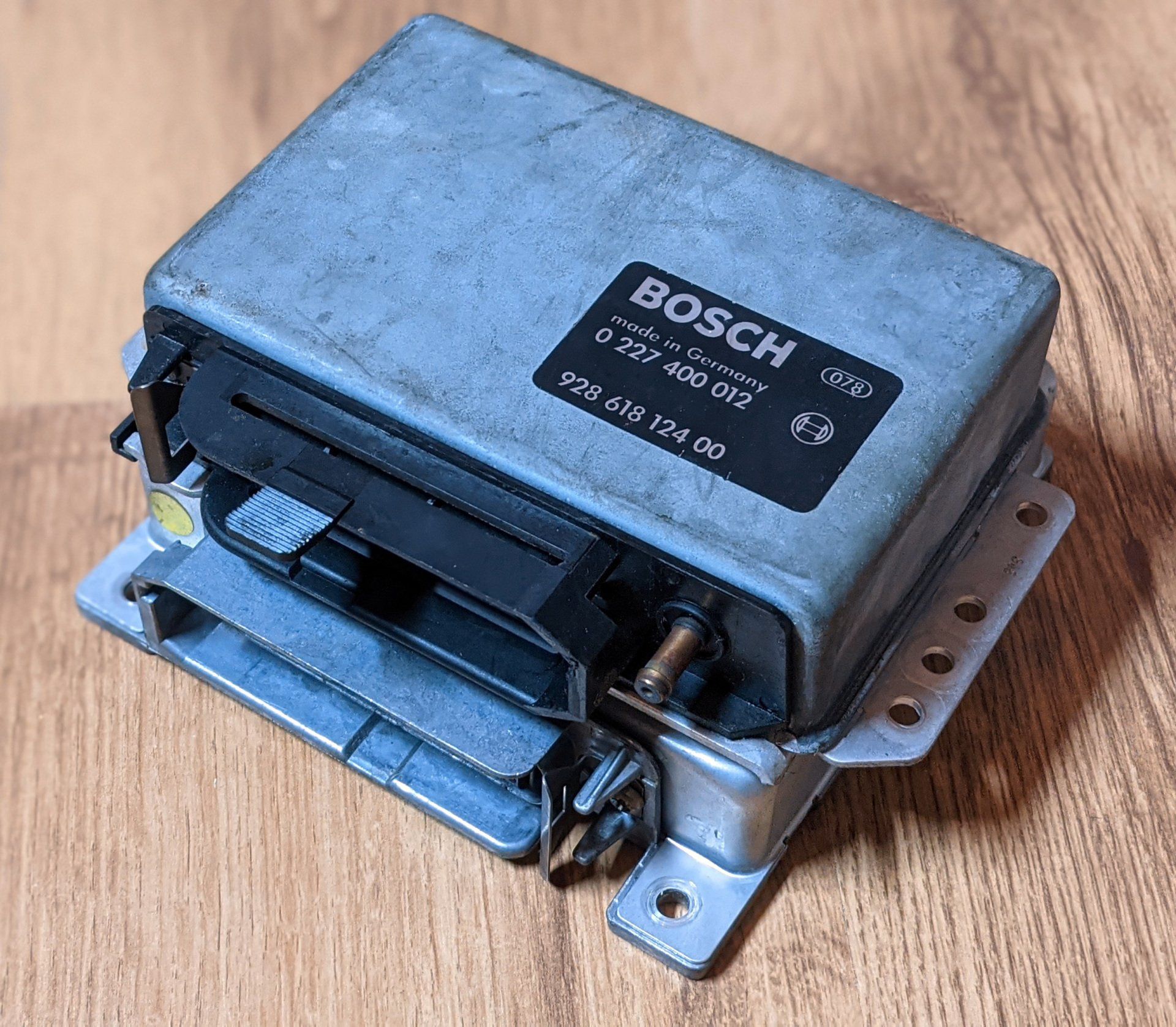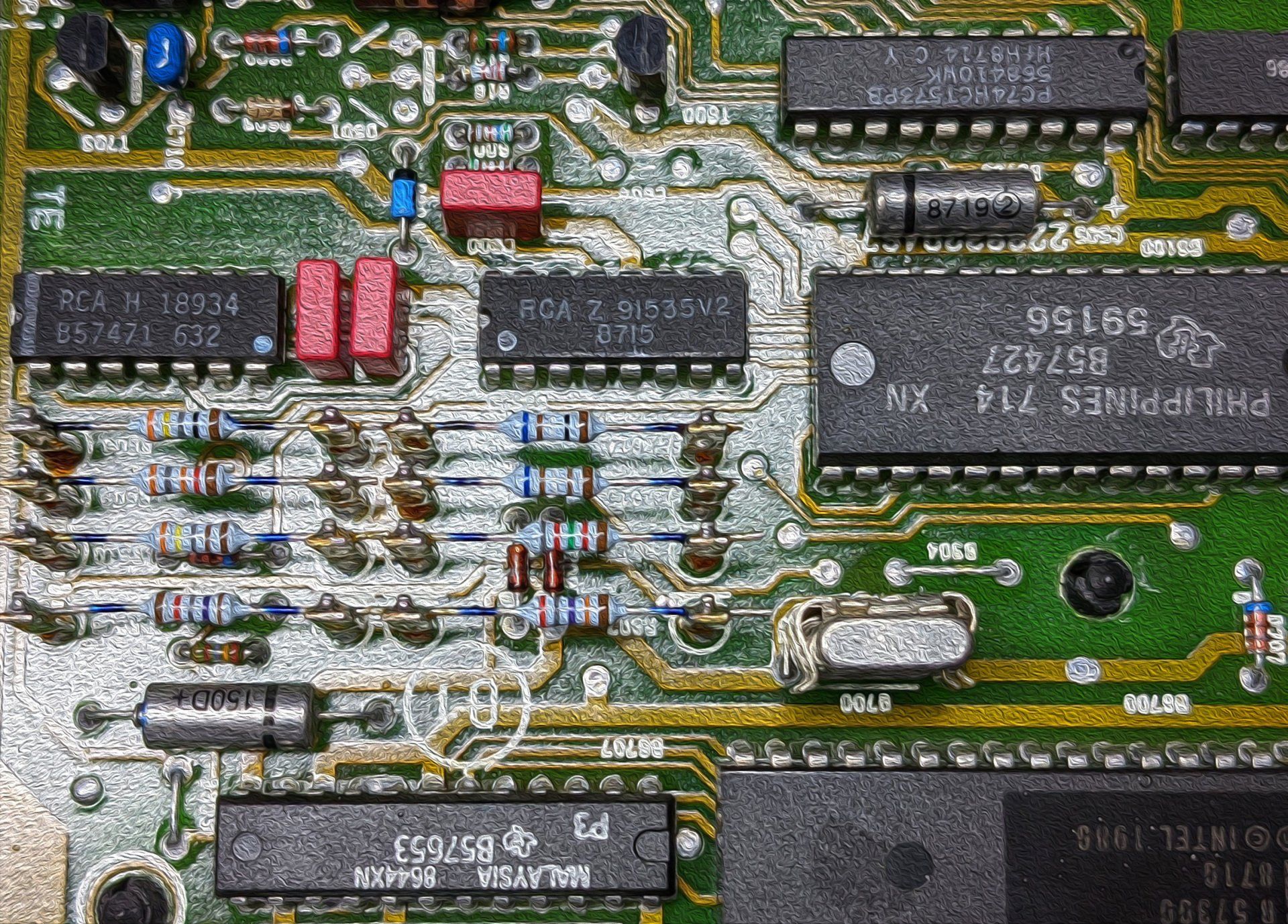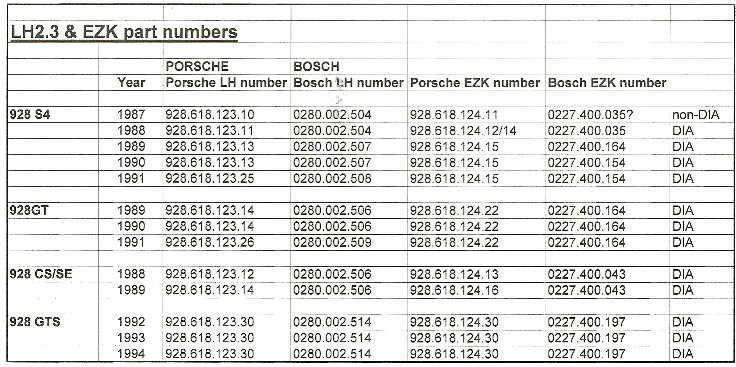Bosch LH2.3
The Bosch LH 2.3 ECU Circuit Board from August 1986 (Porsche 1987 model year) with the introduction of the S4 model, all 928 models used the Bosch LH 2.3 Jetronic fuel injection ECU (sometimes called the “Brain”).
The Porsche part numbers are in a series 928.618.123.10 to 928.618.123.30. The corresponding Bosch part numbers are 0280.002.504 to 0280.002.514 respectively. These are used in the S4, CS, SE, GT and GTS models.
These ECUs have a poor reliability history. This is almost entirely due to failure of the “tile” – a Thick Film hybrid circuit exclusive to Bosch. JDSPorsche has developed a re-engineered replacement for this vital component.
A common LH ECU failure is for the fuel pump to fail to run due to the fuel pump relay not being energised by the LH ECU. Often, a regular clicking will be heard in the engine bay as soon as the ignition is switched on.
We are now able to offer re-manufactured LH ECUs to Porsche enthusiasts, at a very competitive price. Due to the large number of variants of the basic unit, it is often not possible to offer an exchange unit from stock. Your faulty unit can usually be turned around by our workshop in 3 working days. ( Please see the FAQs for more information).
Bosch LH2.3 EZK ignition ECU
EZK box from August 1986 (Porsche 1987 model year) with the introduction of the S4 model, all 928 models used the Bosch LH 2.3 Jetronic Ignition ECU. This was used in conjunction with a separate ECU for the fuel delivery system - the LH ECU.
The Porsche part numbers are in a series 928.618.124.11 to 928.618.124.30. The corresponding Bosch part numbers are 0227.400.035 to 0227.400.197 respectively. These are used in the S4, CS, SE, GT and GTS models.
The EZK ECU takes engine speed pulses from a sensor on top of the engine bellhousing from a gearwheel below. These pulses are processed in the EZK ECU, and the ignition timing is fully mapped according to engine rpm, throttle opening, engine temperature. The output of the EZK is used to trigger two external output stages which drive the twin ignition coils.
These ECUs are usually very reliable. However there are now a significant number of these units failing, and accordingly JDSPorsche have constructed a dedicated test rig in order to fault find and repair these units
What about the earlier cars with LH2.2 and EZ-F fitted to the S2 from 1984-1986?
We've got you covered.
These ECUs are far less prone to issues but they can be tested for a nominal fee and repaired if needed.
LH FAQ
JDSPorsche will rebuild your LH 2.3 Fuel Injection ECU at a competitive price. We can also offer a checking service to assist your fault finding. The following FAQ has been compiled for your information, and we hope you find it interesting and useful.
What does the LH ECU actually do?
LH stands for the Hot wire measurement of the mass of air flowing into the engine, where it is mixed with the appropriate volume of fuel to ensure proper combustion. See the FAQ on the LH Mass Air Flow meter (MAF) for an explanation of this method. ECU is the acronym for Electronic Control Unit. The LH ECU is a mini-computer that takes the input from various sensors such as water temperature, engine rpm, MAF output (engine load) and oxygen sensor, and then calculates many times a second the precise time that the fuel injectors should be opened to inject the correct amount of fuel.
So what does 2.3 signify?
This is the version of the Bosch computer that is used in the Porsche 928 from the 1987 model year until the car ceased production in 1994. Earlier cars, LH equipped, such as the Euro S2 (84 -’86) and the US market early 32v (’85 – ’86) used the LH 2.2 system.
But doesn't the ECU control both the fuel injection and the ignition system?
This is true for some systems, such as the Bosch Motronic, as used on the Porsche 944. The Porsche 928 used separate fuel “LH” and ignition “EZK” ECU’s for all cars with the LH system.
Why did Bosch upgrade from the 2.2 to the 2.3 system?
The 2.3 system used a faster computer in the ECU, and a larger memory to enable more complex processes to be controlled. This was required mainly to meet increasingly stringent emissions standards. The LH2.3 has a sophisticated O2 loop system when catalytic converters are mandatory. It also controls devices other than just the fuel injectors, such as the intake resonance flap for improved mid-range torque, the venting of the fuel tank to the activated carbon canister, and the idle stabiliser. It also has a “Adaptation” system, where changes due to ageing in some of the sensors can be compensated for using the oxygen loop as a correction standard. From 1988 MY, a self diagnostic and fault storage system was built into the unit, which could then be read out with the aid of the Bosch “Hammer”. These units can be recognised with the legend “DIA” marked on the case.
What part numbers apply to these LH ECUs, and how can I tell them from the earlier LH2.2?
The LH2.2 has a 25 way connector, the LH2.3 has 35 ways. The LH2.3 has Porsche numbers in the range from 928.618.123.10 to 928.618.123.30. See the table below for a listing of the numbers.
So what’s the difference between all these types?
The difference is generally in the programme memory that is used by the ECU. For each model of car, Porsche and Bosch carefully optimised the fuelling to suit the different engines. Parameter such as cam design, exhaust system, and valve sizes will all affect the optimum fuelling required. These values are usually gathered using a rolling road dynamometer, and take typically several hundred hours for a road going car which must be tractable and easy to drive in traffic, but (especially for a Porsche) have excellent power when required. All this whilst meeting stringent emissions regulations, and under all environmental conditions. The data takes the form of a 3 dimensional “map” – engine load (MAF voltage), engine rpm and the injector on time required.
Where is the map stored?
In a non-volatile memory chip called an EPROM (Electrically Programmed Read Only Memory). Non-volatile means it will retain its memory contents even when it is switched off. “Read Only” means that in normal use, the processor can’t change the memory contents, as is possible with other types of memory device, such as RAM (Random Access Memory) as used in your PC. The EPROM is programmed at the factory using a special type of programmer. The EPROM is plug in, rather than soldered, so that changing the identity of an ECU is possible by changing the EPROM with one with different code maps.
How do I identify which is the correct ECU for my car, I think it has been changed at some time, I want to check it is the right one?
See the table below:
Help, I’ve discovered it’s the wrong type!
It can possibly be “cloned” to change to another version. Please mail to info@jdsporsche.com for help and advice.
I've heard these units are prone to failure, how does that usually show up?
A common failure is for the engine to “die” and fail to re-start. Or just fail to start! Investigation will often show that the fuel pump is not being activated by the LH ECU. If the fuel pump is bridged, then a regular clicking may be heard under the bonnet (hood) as soon as the ignition is on.. As this is the injectors being energised, the engine will be flooded if there is pressure in the fuel rails, and it will be hard if not impossible to start. Sometimes the injectors will click when ignition is on, even without the fuel pump relay being bridged.
Any other failure modes?
Another common problem is that the car will not idle steadily and reliably. However, all other possibilities for this problem should be investigated first, such as false air leaks into the manifold system, a sticking or faulty idle stabiliser unit. This may require removal of the inlet manifold system. Consult your local Porsche Specialist if you require assistance.
Was it something I did that made it fail ?
The LH2.3 ECUs are very easily damaged by voltage spikes and surges. We recommend:
- Never try to jump start the car :- disconnect the battery earth (ground ) lead and charge the battery first.
- Never use a “rapid charger” with the battery ground connected.
- Never do welding on the car without disconnecting the battery AND also disconnecting the 35way connector on the LH2.3 (and the EZK!)
- A faulty alternator, which allows the battery voltage to rise above 16v can destroy the ECU.
- Never do any electrical work on the car without disconnecting the battery, if at all possible. Otherwise at least make sure the ignition is switched off – at your risk!
- Flashovers from faulty ignition leads can damage the ECUs
- Connecting the battery with reverse polarity is a sure way to toast your ECU's
How do I tell if the ECU has failed?
If your car is MY ’88 onwards, then a Bosch “Hammer” is the quickest way to confirm possible LH2.3 ECU total failure. Note that more subtle faults will not always be registered with the Hammer. The “no start” symptoms above – fuel pump not energising, and a regular clicking noise from the engine are tell-tail signs for the DIY mechanic. A methodical check of the usual suspects - fuel pressure, spark, compression is required. If the engine just “stopped” at high rpm, check the cambelt is still intact by removing one of the upper covers.
I’m fairly sure the ECU has failed, but I need a definitive check. It’s not practical to trailer the car to a Porsche Specialist.
Try to find someone with a 1987 or later car whil will lend you their LH ECU. It doesn’t matter if it is not the same model as yours. The car will start and run with any version. If you can’t borrow an ECU, you can send yours to JDSPorsche and for a nominal fee we will check it out on our test jig for you.
I’ve managed to source another ECU, but it’s the wrong type number. Can it be adapted to suit my car?
It is often possible to change the identity of the ECU by changing the EPROM to the correct type, for optimum running with your car. E-mail JDSPorsche for more information.
How do I remove the ECU from my car?
You will need to extract both ECU's together on their cradle. Some people report it is easier to take out the passenger parcel shelf. Disconnect the battery before starting this procedure! The units are located in the passenger footwell. Fold back the carpet, to expose the ECUs on their cradle. Remove the cover over the fuse and relay board.
Unplug the ECUs by pulling the extractor lever up, that will pull most of the plug out. You then have to rotate the whole connector about the end opposite the lead, to disengage the connector completely. There is "usually" enough slack in the cable to let you do this before loosening the cradle. Once disconnected (and also the ignition protection relay that also lives on the cradle from 1989 models onwards), unbolt the cradle complete with ECUs. They can then be unbolted from the cradle.
I thought digital electronics were really reliable - they put men on the moon. Why do these ECUs seem to fail so frequently?
Although the LH2.3 is in general a well designed unit, its weak point is the Thick Film hybrid circuit, sometimes known as the “Slate” or the “Tile”, which has proved to be fragile both electrically and mechanically.
How does JDSPorsche repair these faulty units?
We have re-engineered the “tile” with a rugged version that is well protected to suit the difficult environment found in a motor car. Any other components that may be suspect , or likely to fail due to their age are also replaced. The repaired unit is then tested for all required functionality on our specially built test rig.
How long will it last now?
We would still recommend that the guidelines listed above are adhered to. We believe that the re-engineered ECU will last many years to come. However, bear in mind that a refurbished unit is not a “new” unit.
What warranty do you offer?
We offer a 3 year warranty as regards our workmanship and the components we fit. (5 years for EPROMS) Any obvious abuse of the unit will render the warranty invalid. Modifications to the car’s systems are beyond our control, and are at owners’ risk. We will honour our warranty for our work. Our warranty does not extend beyond this in any respect whatsoever.
All Rights Reserved | MJ Parris Consulting Ltd.
Terms & Privacy
JDSPorsche has no affiliation with Porsche AG, or their associate companies. All trademarks belong to their respective owners.



